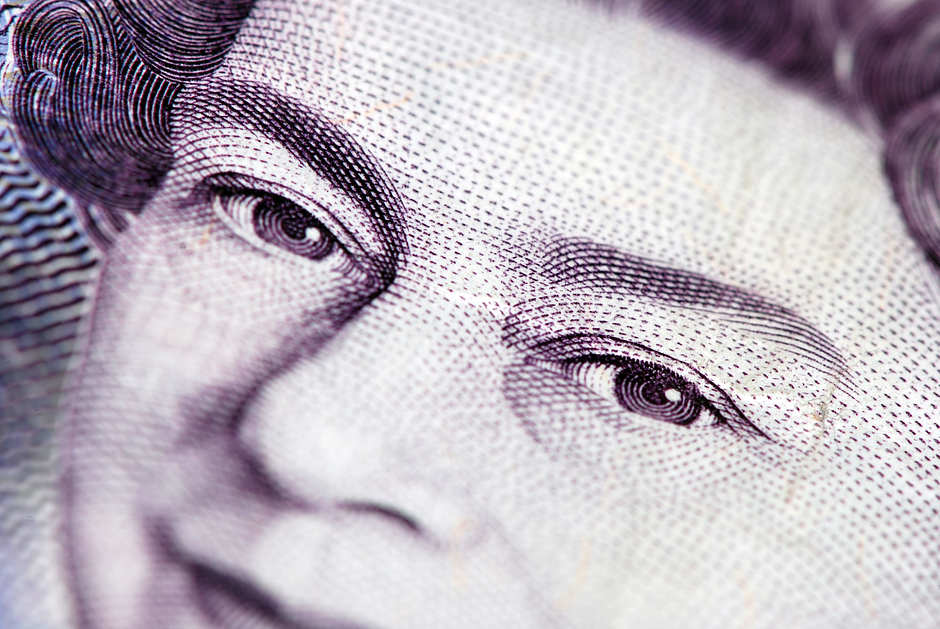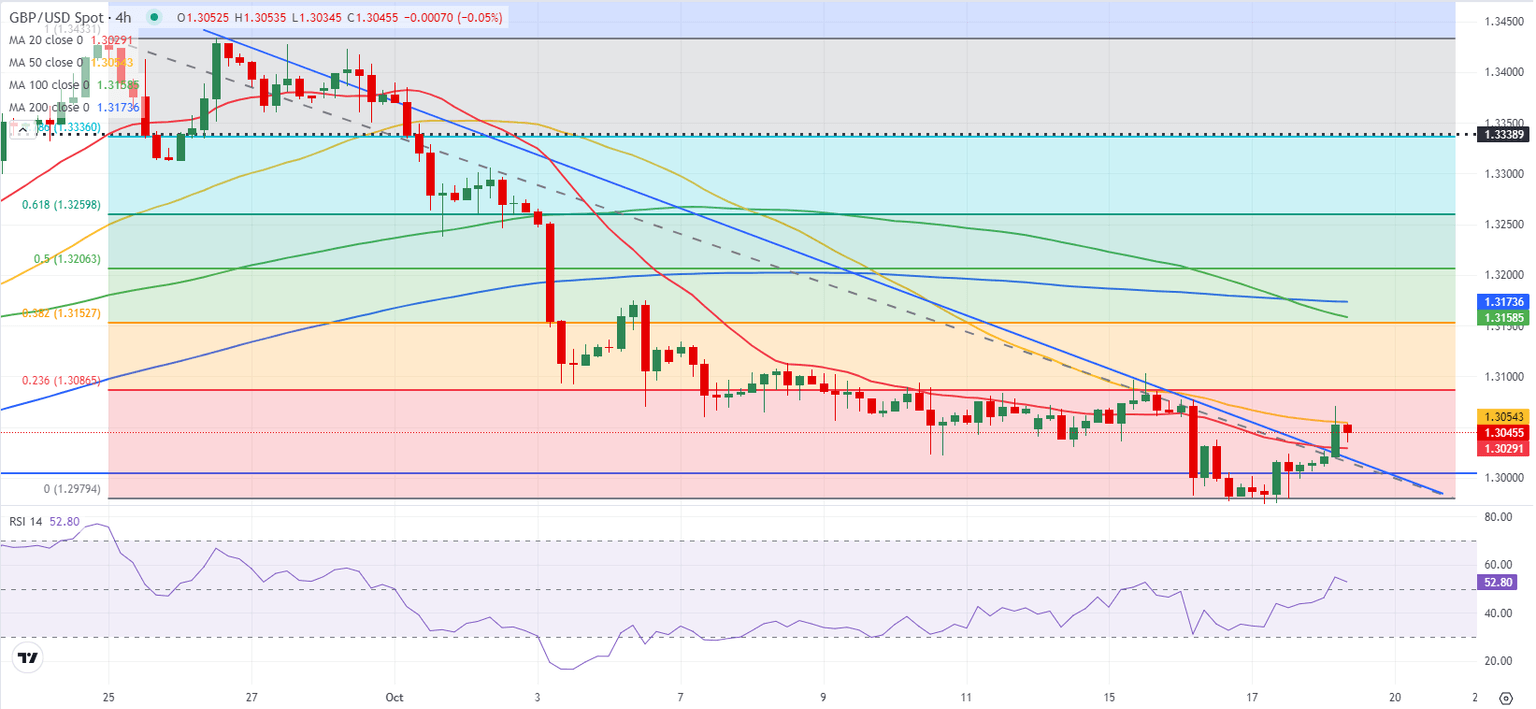GBP/USD Forecast: Pound Sterling is not out of the woods yet
- GBP/USD trades in positive territory slightly below 1.3050 on Friday.
- The sharp decline seen in EUR/GBP helped Pound Sterling gather strength.
- The pair could extend its recovery if risk mood continues to improve.

GBP/USD ignored the persistent US Dollar (USD) strength and closed in positive territory on Thursday. The pair continued to edge higher early Friday and advanced to the 1.3050 area. In the absence of high-impact data releases, the risk mood could impact GBP/USD's action heading into the weekend.
British Pound PRICE This week
The table below shows the percentage change of British Pound (GBP) against listed major currencies this week. British Pound was the weakest against the US Dollar.
| USD | EUR | GBP | JPY | CAD | AUD | NZD | CHF | |
|---|---|---|---|---|---|---|---|---|
| USD | 0.92% | 0.19% | 0.51% | 0.16% | 0.56% | 0.59% | 1.12% | |
| EUR | -0.92% | -0.79% | -0.52% | -0.67% | -0.33% | -0.41% | 0.11% | |
| GBP | -0.19% | 0.79% | 0.27% | -0.00% | 0.50% | 0.43% | 0.89% | |
| JPY | -0.51% | 0.52% | -0.27% | -0.34% | 0.08% | 0.14% | 0.61% | |
| CAD | -0.16% | 0.67% | 0.00% | 0.34% | 0.35% | 0.46% | 0.78% | |
| AUD | -0.56% | 0.33% | -0.50% | -0.08% | -0.35% | 0.05% | 0.52% | |
| NZD | -0.59% | 0.41% | -0.43% | -0.14% | -0.46% | -0.05% | 0.46% | |
| CHF | -1.12% | -0.11% | -0.89% | -0.61% | -0.78% | -0.52% | -0.46% |
The heat map shows percentage changes of major currencies against each other. The base currency is picked from the left column, while the quote currency is picked from the top row. For example, if you pick the British Pound from the left column and move along the horizontal line to the US Dollar, the percentage change displayed in the box will represent GBP (base)/USD (quote).
Following the sharp decline seen on Wednesday, GBP/USD found a foothold on Thursday. Although the USD held resilient against its major rivals, Pound Sterling managed to capture capital outflows out of the Euro. Following the European Central Bank's (ECB) decision to lower key rates by 25 basis points and President Christine Lagarde's dovish commentary, EUR/GBP fell nearly 0.5% on Thursday.
The data published by the UK's Office for National Statistics showed early Friday that Retail Sales rose 0.3% on a monthly basis in September. This reading followed the 1% increase recorded in August and came in better than the market expectation for a decline of 0.3%, further supporting Pound Sterling.
Meanwhile, the bullish action seen in the major Asian equity indexes on upbeat Chinese data point to a positive shift in market sentiment on Friday. At the time of press, US Stock index futures were up between 0.1% and 0.4% on the day.
If Wall Street's main indexes rally after the opening bell, the USD could come under selling pressure in the American session and allow GBP/USD to stretch higher.
GBP/USD Technical Analysis
GBP/USD trades above the descending trend line but the Relative Strength Index (RSI) indicator on the 4-hour chart edges lower toward 50, pointing to a lack of bullish momentum.
On the upside, 1.3090-1.3100 (Fibonacci 23.6% retracement of the latest downtrend, static level) aligns as first resistance area before 1.3130 (50-day Simple Moving Average(SMA)) and 1.3175 (20-day SMA).
Looking south, supports could be spotted at 1.3000 (static level, round level), 1.2980 (end point of the downtrend) and 1.2960 (100-day SMA).
Pound Sterling FAQs
The Pound Sterling (GBP) is the oldest currency in the world (886 AD) and the official currency of the United Kingdom. It is the fourth most traded unit for foreign exchange (FX) in the world, accounting for 12% of all transactions, averaging $630 billion a day, according to 2022 data. Its key trading pairs are GBP/USD, also known as ‘Cable’, which accounts for 11% of FX, GBP/JPY, or the ‘Dragon’ as it is known by traders (3%), and EUR/GBP (2%). The Pound Sterling is issued by the Bank of England (BoE).
The single most important factor influencing the value of the Pound Sterling is monetary policy decided by the Bank of England. The BoE bases its decisions on whether it has achieved its primary goal of “price stability” – a steady inflation rate of around 2%. Its primary tool for achieving this is the adjustment of interest rates. When inflation is too high, the BoE will try to rein it in by raising interest rates, making it more expensive for people and businesses to access credit. This is generally positive for GBP, as higher interest rates make the UK a more attractive place for global investors to park their money. When inflation falls too low it is a sign economic growth is slowing. In this scenario, the BoE will consider lowering interest rates to cheapen credit so businesses will borrow more to invest in growth-generating projects.
Data releases gauge the health of the economy and can impact the value of the Pound Sterling. Indicators such as GDP, Manufacturing and Services PMIs, and employment can all influence the direction of the GBP. A strong economy is good for Sterling. Not only does it attract more foreign investment but it may encourage the BoE to put up interest rates, which will directly strengthen GBP. Otherwise, if economic data is weak, the Pound Sterling is likely to fall.
Another significant data release for the Pound Sterling is the Trade Balance. This indicator measures the difference between what a country earns from its exports and what it spends on imports over a given period. If a country produces highly sought-after exports, its currency will benefit purely from the extra demand created from foreign buyers seeking to purchase these goods. Therefore, a positive net Trade Balance strengthens a currency and vice versa for a negative balance.
Premium
You have reached your limit of 3 free articles for this month.
Start your subscription and get access to all our original articles.
Author

Eren Sengezer
FXStreet
As an economist at heart, Eren Sengezer specializes in the assessment of the short-term and long-term impacts of macroeconomic data, central bank policies and political developments on financial assets.


















